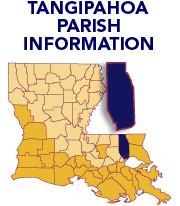 |
| |

Click on a parish to change parishes. |
| |
|
| |
|
| |
|
| |
|
| |
|
| |
PARISH PLANNING BASELINE |
|
|
|
|
| |
|
| |
| |
| |
|
| |
|
| |
 |
|
|
 |
Tangipahoa Parish
Tangipahoa is among the, “Florida Parishes” (part of the Spanish Florida panhandle) and remained outside US control well after the Louisiana Purchase. Therefore, it has a history and culture distinct from French and Cajun areas of the state. This area was part of an independent nation after 1803. The original peoples of Tangipahoa included the Acalpissa Tribe and their language survives in the names of the area’s many beautiful streams and creeks. Tangipahoa roughly means, "ear of corn" in their language.
The parish economy relies on timber, light manufacturing and agriculture - particularly strawberries in the Hammond area.
Tangipahoa residents, when asked what the valued most about their community, responded:
“We treasure our rural lifestyle, small community living, the dairy industry, and Southeastern University.”
|
|

 |
- Tangipahoa is a Native-American (Acolpissa) term that means "ear of corn" or "those who gather corn."
- Hammond is known as the Strawberry Capital of America.
- It covers 790 sq. miles in land area and a population density of 133.1 per square mile. In the last three decades of the 1900s, its population grew by 52.7%.
- The average household size is 2.66 persons compared to an average family size of 3.19 persons.
- In 2004 retail trade was the largest of 20 major sectors. It had an average wage per job of $20,966. Per capita income grew by 16.6% between 1993 and 2003 (adjusted for inflation).
- The parish seat is Amite.
- Larger communities are Amite, Hammond, Independence, Kentwood, Ponchatoula and Tickfaw.
- Pre-storm, the population was 105,000.
- Significant economic interests are truck farming, Public Administration (local government and schools), warehousing, timber, construction, retail, light manufacturing.
|
|
|